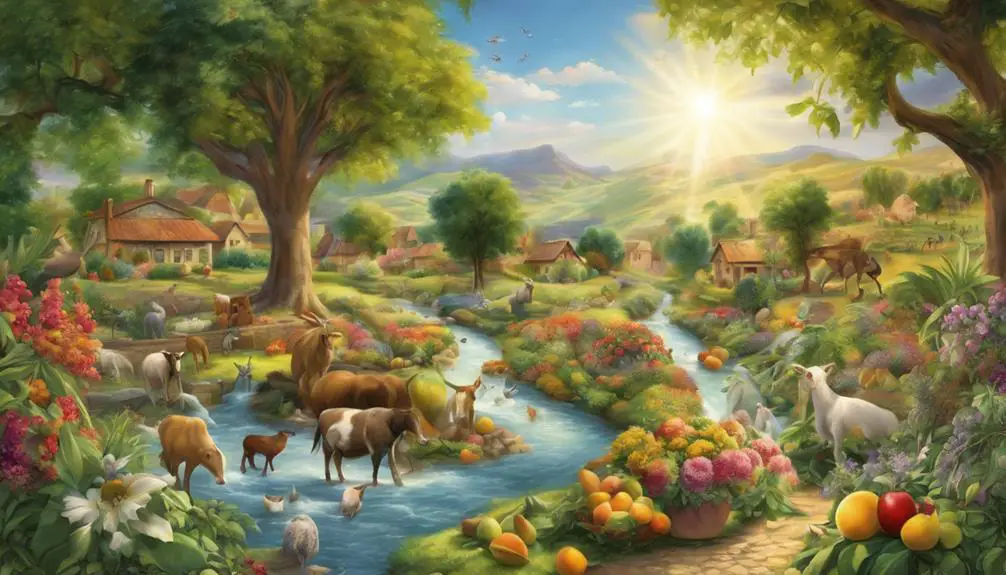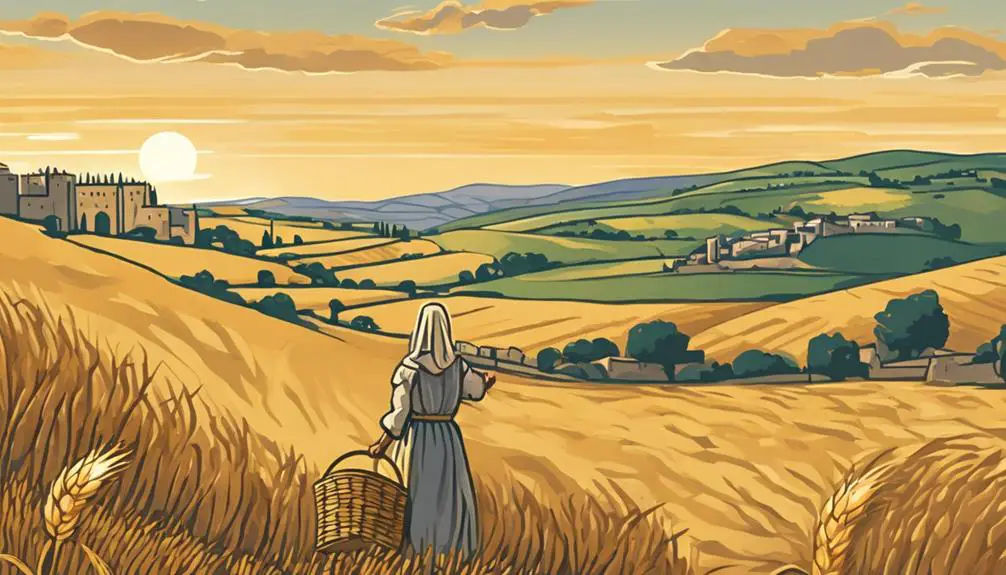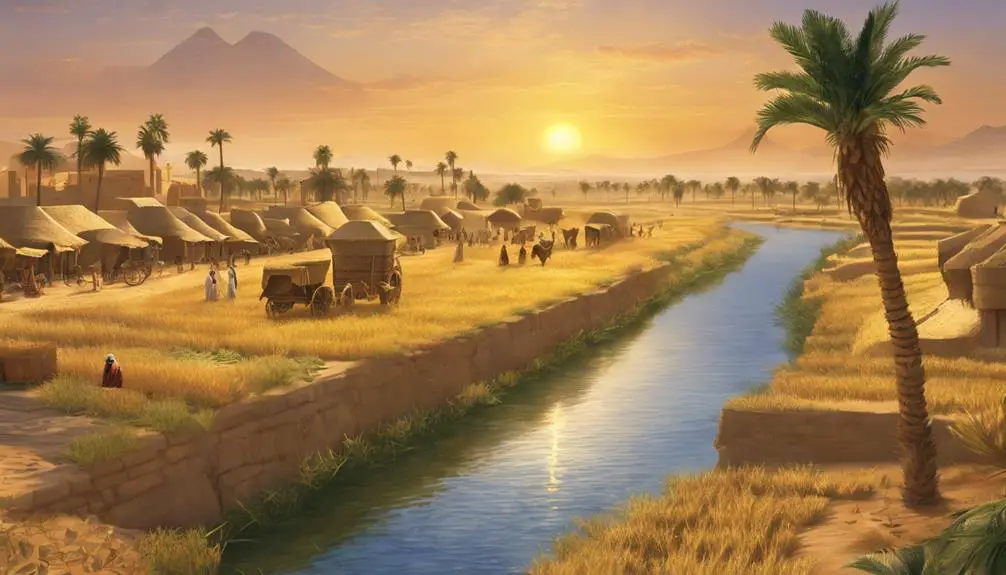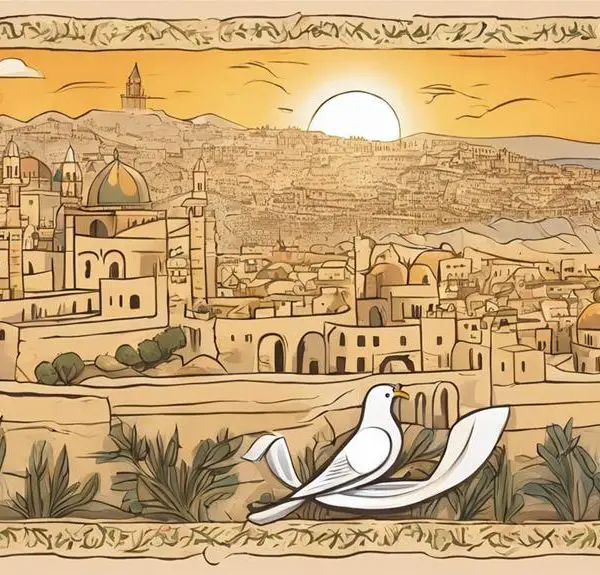Explore the biblical farms beginning with 'B' to uncover hidden stories and meanings in ancient agricultural settings—discoveries await.

Names of Farms in the Bible
As you sow, so shall you reap—a principle vividly illustrated by the farms and agricultural settings of the Bible. You've likely heard of Eden, humanity's first farm, a place of unmatched beauty and abundance. But have you explored the less spoken of, yet equally significant, agricultural sites like the vineyards of Naboth or the fertile fields of Boaz?
These locations are more than mere backdrops; they're pivotal to understanding the socio-economic and spiritual contexts of their times. Unpack their stories, and you'll uncover layers of meaning that could shift your perspective on biblical narratives.
Let's start this journey together, shall we?
Key Takeaways
- The Garden of Eden represents the biblical origin of agriculture and land stewardship.
- Naboth's Vineyard underscores the importance of ancestral land and ethical land use.
- Fields of Boaz exemplify generosity, communal support, and the blessing of hard work.
- Gethsemane Olive Grove highlights ancient cultivation methods and spiritual significance.
Eden: Humanity's First Farm

While the Garden of Eden is often depicted as a divine paradise, it arguably represents humanity's first encounter with agriculture, setting the foundational narrative for human interaction with the land. This narrative isn't merely a historical or religious recount; it's imbued with deep layers of garden symbolism that speak volumes about the human condition and our relationship with the earth.
You see, Eden wasn't just about the abundance of food; it was about the responsibilities that came with tending to the land. The act of caring for the garden—pruning, planting, harvesting—symbolizes the dawn of agricultural practices. It's a vivid portrayal of humans transitioning from nomadic lifestyles to sedentary agriculturists, learning to cultivate the land and, in turn, forge civilizations.
This shift wasn't just physical; it was profoundly spiritual. The garden symbolizes a sacred space where humans and nature coexist harmoniously, guided by divine stewardship. This intertwining of the sacred and the mundane through agricultural practices highlights a reverence for the land, a lesson as vital today as it was in antiquity.
Thus, Eden's narrative lays the groundwork for understanding our historical and ongoing relationship with agriculture, teaching us about stewardship, sustainability, and the sacredness of the land.
The Vineyards of Naboth
How does the story of Naboth's vineyard deepen our understanding of agricultural symbolism and land ethics in biblical narratives? This narrative isn't just a tale of royal greed clashing with a man's right to his inheritance; it's a complex exploration of the values tied to the land and its produce in ancient societies.
- Naboth's Inheritance: Naboth's vineyard wasn't merely a piece of land; it was his ancestral inheritance, symbolizing his family's history and their connection to the land. This deep bond underscores the biblical reverence for land as a God-given stewardship, not merely an asset to be acquired.
- Royal Greed: King Ahab's desire for Naboth's vineyard represents the dangers of unchecked power and greed. The king's willingness to manipulate and even commit murder to obtain the vineyard illustrates the moral corruption that can arise from the pursuit of personal desire over communal well-being.
- Land Ethics: The vineyard story critiques the exploitation of resources and people, advocating for a moral framework where land is respected and preserved for future generations. It's a call for ethical stewardship that resonates even today.
In essence, the tale of Naboth's vineyard serves as a poignant reminder of the sacredness of land and the dangers of greed, offering enduring lessons on justice and ethical land use.
Fields of Boaz

In the biblical narrative, the fields of Boaz emerge as a pivotal setting where themes of generosity, redemption, and the importance of agricultural practices intertwine, revealing deep insights into ancient Hebrew society and its values. Here, you witness Ruth's diligence firsthand as she gleans in the fields to provide for herself and Naomi, her mother-in-law. Boaz's fields aren't just a backdrop; they're a testament to the societal norms and the virtues of hard work and kindness.
Aspect |
Significance |
|---|---|
Generosity |
Boaz allows Ruth to glean, showcasing the value of kindness and support within the community. |
Redemption |
Ruth's actions in the fields lead to her marriage with Boaz, a symbolic act of familial redemption. |
Harvest Celebrations |
The fields are a stage for festivities, reflecting the joy and communal spirit during harvest time. |
These fields represent more than just physical locations; they symbolize the intersection of personal initiative and divine provision. Ruth's diligence in these fields not only secures her and Naomi's survival but also integrates her into a new community, highlighting the importance of perseverance and faith. The narrative emphasizes that the fruits of one's labor, when combined with communal support, pave the way for redemption and joy.
Gethsemane: An Olive Grove
Shifting focus from the agricultural fields of Boaz to the sacred olive grove, Gethsemane reveals another layer of biblical narrative steeped in symbolism and profound spiritual significance. You'll find that Gethsemane's history isn't just about olives; it's a story interwoven with deep religious undertones and practices.
- Olive Cultivation Techniques: Ancient methods of cultivating olives in Gethsemane were sophisticated for their time. They involved careful selection of terrain, ensuring adequate sunlight and drainage, which are crucial for the olive trees to thrive. These practices underscored the importance of olives in the local economy and daily life.
- Religious Symbolism of Olives: Olives are deeply symbolic in biblical texts. They represent peace, prosperity, and divine blessing. Gethsemane, with its olive grove, stands as a testament to these themes, offering a serene backdrop to pivotal moments in religious history.
- Gethsemane's Role in Scripture: Beyond its agricultural significance, Gethsemane is central to the narrative of Jesus' last night before his crucifixion. The olive grove becomes a place of prayer and contemplation, symbolizing the agony and submission to divine will.
In analyzing Gethsemane, you're peering into a site that captures both the essence of ancient olive cultivation and the profound spiritual symbolism that has resonated through ages.
The Fertile Lands of Egypt

The fertile lands of Egypt, cradled by the life-giving waters of the Nile, have long been pivotal in shaping the agricultural and economic landscapes of ancient civilizations. You'll find that the Nile's annual flooding bestowed Egypt with rich silt, creating an agricultural haven that stood in stark contrast to the surrounding deserts. This bounty, however, required sophisticated management to harness effectively. Nile irrigation techniques, therefore, emerged as a cornerstone of Egyptian farming, allowing for the cultivation of crops year-round in some areas. Through a network of canals and basins, Egyptians meticulously controlled the distribution of Nile water, optimizing agricultural output.
Central to this narrative is Joseph's grain management, an insightful case of ancient wisdom applied to agriculture. Amid predictions of famine, Joseph's strategic accumulation and rationing of grain underscored the importance of planning and resource management in sustaining Egypt's populace. His efforts exemplify how foresight and innovative practices were instrumental in mitigating the adverse effects of natural calamities.
Thus, the fertile lands of Egypt, enriched by the Nile and managed through advanced techniques and strategic foresight, underscore the intertwined nature of environmental resources and human ingenuity in the annals of agricultural history.
Frequently Asked Questions
How Did the Naming Conventions for Farms and Agricultural Lands in Biblical Times Influence Modern-Day Farm Naming Practices?**
When examining how ancient naming conventions have shaped modern farm names, you'll find a significant impact. These historical trends often blend with contemporary influences, leading to a rich tapestry of names that reflect both heritage and current trends.
What Archaeological Evidence Exists to Support the Locations and Existence of the Farms Mentioned in the Bible?**
You're diving into a historical treasure trove, seeking the truth behind ancient farms. Geophysical surveys act as your map, revealing the contours of long-forgotten lands.
Artifact dating, your compass, points to the epochs these farms thrived. Together, they paint a vivid picture, a scholarly insight into the past.
This evidence not only confirms their existence but also enriches our understanding of agricultural practices in ancient civilizations, bridging gaps in our historical narrative.
Are There Any Significant Differences in Farming Techniques Between the Farms Mentioned in the Bible and Those Used in Contemporary Agriculture?**
Absolutely, there are significant differences in farming techniques between ancient times and today's methods. Back then, techniques were largely guided by the natural rhythms and manual labor, with limited tools.
Today, you've got advanced technology, climate adaptation strategies, and sophisticated soil management practices. These modern approaches allow for more efficient and sustainable farming, demonstrating how far agriculture has evolved from the basic, labor-intensive methods once used.
How Did the Economic and Social Status of Farm Owners in the Bible, Like Boaz and Naboth, Compare to the Average Landowner of Their Time?**
You're exploring how figures like Boaz and Naboth stacked up economically and socially against their contemporaries.
Boaz's generosity wasn't just kindness; it reflected his substantial wealth and high status, distinguishing him from the average landowner.
Naboth's vineyard controversy, on the other hand, highlights the vulnerabilities even prosperous landowners faced.
Their stories, analyzed deeply, reveal the complex interplay of wealth, status, and power in their society, offering a nuanced view of historical landownership dynamics.
Can the Crops and Produce Grown in These Biblical Farms Be Directly Linked to the Diets and Culinary Practices of Ancient Peoples Mentioned in the Bible?**
You're exploring how the crops and produce from ancient times tie into the diets and culinary customs of biblical peoples. It's crucial to consider the dietary laws impact and the ingredients used in religious feasts.
Conclusion
In dissecting the agrarian tapestry of the Bible, it's evident that these farms aren't just sources of sustenance but deeply symbolic landscapes. From Eden's lost paradise to Gethsemane's somber olive trees, they're fertile ground for theological and moral exploration.
Like peeling an onion, delving into these biblical farms reveals layers of cultural, ethical, and spiritual significance. In essence, they're not merely plots of land but rich narratives that cultivate insights into humanity's relationship with the divine and the earth.



Sign up